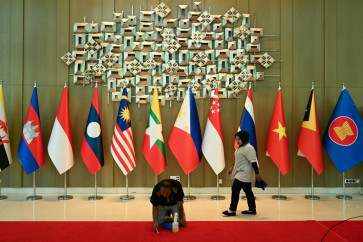Finding the `middle ground'
Copenhagen is fast approaching
Change text size
Gift Premium Articles
to Anyone

C
openhagen is fast approaching. The road to achieving a global climate treaty, nevertheless, will be a thorny one.
One of the potential deadlocks will be the negotiations on shared vision - a vision that needs to have the right level of ambition to bring about reductions in emissions that are high enough to ensure the survival of the most vulnerable nations, communities and ecosystems.
A credible scientific body, the Intergovernmental Panel on Climate Change (IPCC), provides the lowest mitigation scenario category, which stabilizes greenhouse gas concentrations in the range of 445-490 ppm CO2 equivalent, leading to temperatures of 2 to 2.4 degrees Celsius higher than pre-industrial levels in the long term. To achieve this, emission reductions for industrialized countries have to be at the high end of the IPCC - 25 to 40 percent reduction.
Prior to the Copenhagen COP (Conference of Parties)-15 of the UN Framework Conventions on Climate Change (UNFCCC) this December, different individual countries and major blocks of countries have stated their targets. However, the current proposed emission targets rather befit temperature rises of 3 to 4 degrees Celsius, an inconsistency that threatens the survival of entire nations and precious ecosystems around the world.
For instance, EU member states committed themselves to cutting the EU's greenhouse gas emissions by 20 percent by 2020, compared with 1990 levels, with a promise to move to 30 percent if other industrialized countries follow suit.
The new Japanese government has recently moved its target from an 8 percent reduction in emissions by 2020 on 1990 levels to a 25 percent reduction, provided that the upcoming international agreement includes big developing countries like China and India.
Other industrialized countries, including the US, have yet to come up with stronger targets. As the only Annex I country that is not a signatory to the Kyoto Protocol, leadership from the US is needed. The country must join a strong new international agreement in Copenhagen by adopting an economy-wide quantified emission reduction commitment, reflecting its history as the largest emitter of greenhouse gases.
Based on the overall compilation of national data, industrialized nations are planning average cuts in greenhouse gas emissions of between 10 and 14 percent below 1990 levels by 2020 as part of a new UN climate pact. This falls sharply short of what the science has suggested.
As mentioned by Japan and echoed by many industrialized countries, there is significant pressure on newly industrialized countries such as South Korea and Saudi Arabia to take quantified emissions limitation and reduction commitments and on key developing countries (e.g., China, India, Brazil, South Africa and increasingly Indonesia) to also reduce their emissions to less than business as usual by 2020.
This is not an easy subject to negotiate. On the one hand, it is recognized that to achieve the goal of keeping global temperature rises well below 2 degrees Celsius, involvement and contribution of developing countries are key. On the other hand, developing countries have less historical responsibility and capability to act, and hence they require adequate finance, technology and capacity-building support from industrialized countries.
To have this sort of trade-off, developing countries can put forward Nationally Appropriate Mitigation Actions (NAMAs). Developing countries' actions, as a group, should aim to achieve the emission reductions required, while at the same time leading to the poverty eradication, meeting the Millennium Development Goals and ensuring the right to overall sustainable development.
The group of developing countries has the potential to reduce their actual emissions substantially reaching to 30 percent of deviation below a business as usual (BAU) pathway by 2020, including REDD (reducing emissions from deforestation and forest degradation), provided they receive relevant support from industrialized countries.
The plans to reduce emissions in developing countries should be based on their respective capacities, targeting the heaviest polluters in the country including power generation, deforestation, transport and the built environment. Building from the bottom up, these plans and actions are likely to include policies, measures and perhaps sectoral agreements.
These plans and actions should not be perceived as burdens but as an opportunity for job creation and a healthy society, setting the world on a development path that can be sustained over a long period.
Industrialized countries, therefore, should commit considerable funds to cover the costs of preparing these immediately.
Industrialized and developing countries can all be change agents, but key countries from both sides need to be more proactive and get beyond the finger pointing. Both sides need to understand better each other's key objectives, concerns, aspirations and responsibilities.
More than ever, there is a need for game-changing interventions.
The statement from the British prime minister arguing for the need to offer finance - US$100 billion a year by 2020 - to poorer countries to enable them to begin the transition to low-carbon development and adaptation, for example, is a good starting point, signaling "willingness" by industrialized countries to support developing countries.
The plan by Chinese President Hu, at the United Nations and G20 summits next week, to voice a position on climate change, in particular calling for stronger international efforts on climate change, and to introduce the new measures that China is taking, could well be seen as the "willingness" from developing countries to contribute to climate change solutions.
If other industrialized and key developing countries, including Indonesia, follow these moves and go beyond rhetoric - and putting trust in the joint understanding that all parties will do their fair share to deal with this crisis - we may achieve a desired global climate agreement in Copenhagen. Climate change now really depends on "good" politics from all parties involved.
- Fitrian Ardiansyah









